Guangyuan, a city nurtured by abundant cultural resources
Guangyuan is the birthplace of Empress Wu Zetian of the Tang Dynasty (618-907), the main stronghold of the Three Kingdoms (220-280) culture, and the source of Sichuan-Shaanxi Red Army culture. Home to Jianmen Pass, Cuiyun Corridor, and numerous items of national intangible cultural heritage like Maliu embroidery and Wangcang Duangong Drama, Guangyuan is endowed with gorgeous landscapes, rich history, and abundant cultural relics.
Shu Path Culture
The section of the Shu Path within Guangyuan has a total length of 270 kilometers. It possesses diverse cultural spots and is one of the best-conserved parts of the route. Like a golden string, the route connects the breath-taking landscapes and cultural treasures along its course.
The Shu Path can be defined broadly or narrowly. In a broader sense, it means all outward roads in the Sichuan Basin, including the north-west ancient Tea Horse Road, the south-west Wuchi Road and Shendu Road, and the east-west Jinniu Road and Yinping Road. In a narrow sense, Shu Path refers just to northward roads in Sichuan, including Jinniu Road, Micang Road, Yinping Road and Lizhi Road.
Four ancient routes are part of the World Heritage natural and cultural heritage application that local authorities have filed, including Yinping Road, which connects Sichuan with Gansu, as well as Jinniu Road, Micang Road and Lizhi Road, which connect Sichuan with Shaanxi. Of these, Jinniu Road was the earliest one established as an official postal route connecting Sichuan with Shaanxi. In earlier days, Jinniu Road was also known as Shiniu Road, according to historic records.
Micang Road, serving as a key shortcut connecting Sichuan with Hanzhong, was created later than Jinniu Road. It started to gain recognition in the late Qin Dynasty (221-206 BC) and early Han Dynasty (206 BC - 220 AD).
Yinping Road starts from Yinping city and ends at Jiangyou Pass in Pingwu county (today's Nanba Township). It passes through Wenxian county and Motian Peak in Qingchuan county, then the Tangjia River, Yinping Mountain, Mazhuan Pass and Jinjun Mountain.
Lizhi Road was named after a story, in which Emperor Xuanzong of the Tang Dynasty (618-907) had lychees sent to the capital city for his beloved concubine Yang Guifei.
In this modern age of high accessibility, Shu Path is without any doubt a "fossil of ancient Chinese transport". Song Dynasty (960-1279) poet Lu You wrote in his poem: "In fine rain straddling a donkey I enter Jianmen Pass." People no longer have to ride a donkey on the road anymore, but the historic and cultural value of Shu Path is beyond measure.
Over a long period of history, Shu Path has played a vital role in supporting economic development, national unity, cultural exchanges and regime consolidation.
Three Kingdoms Culture
The history of Three Kingdoms reflects the history of the Shu Path. The Hanzhong Battle along the Shu Path spawned the formation of Three Kingdoms, which ended with a battle between the states of Wei and Shu which also took place along the Shu Path. Sitting at the junction of Sichuan, Shaanxi and Gansu, Guangyuan has enjoyed high military significance since ancient times.
During the Three Kingdoms period, Guangyuan was the main battlefield of the battle between the states of Shu and Wei; indeed it was the site where the two states were established and ended. As a result of slow economic development and a low level of exchanges due to its inaccessibility in earlier ages, Guangyuan has kept a number of cultural elements from the Three Kingdoms Period.
According to incomplete data, Guangyuan now has more than 140 sites dating back to the Three Kingdoms period. Among the most well-known are Jianmen Pass, Mingyue Gorge, Zhaohua Ancient Town, Motian Peak, Cuiyun Corridor and Niutou Mountain. These unique tourism destinations are evenly distributed along the Jinniu Road, Yinping Road, and Micang Road, collectively known as the "Ancient Shu Path". The Jianmen Pass Scenic Spot and Zhaohua Ancient Town in Guangyuan are among the must-sees for those interested in Three Kingdoms culture.
Empress Culture
In the second year of the Zhenguan Reign Period of the Tang Dynasty (618-907), Wu Zetian was born in Lizhou (today's Guangyuan). It is said that a colorful phoenix circled her house and flew towards the eastern mountain right after she was born. Her father, who was then a governor, was so happy that he renamed the mountain Phoenix Mountain.
The most celebrated building to commemorate Empress Wu Zetian is the Huangze Temple. Originally called the Chuanzhu Temple, built to commemorate Li Bing (a famous water conservancy engineering expert in the Warring States period) and his son, the temple was restored under Wu Zetian's regime with imperial funding, along with a change of name.
Dated back more than 1,500 years, the Huangze Temple is the only temple in commemoration of Wu Zetian. Consisting of grand buildings, pavilions, and towers, the temple sits on a high cliff, overlooking the rivers flowing by. It is known for stone carvings that reflect the beauty of the Sichuan landscape.
The other highlight of Huangze Temple is the stone statue of the empress. Many people might wonder what she looked like. Here in the temple, there are two statues of Wu Zentian in her old age, dressed like a goddess of Buddhism. The styling of these statues had much to do with the popularity of Maitreya under her reign.
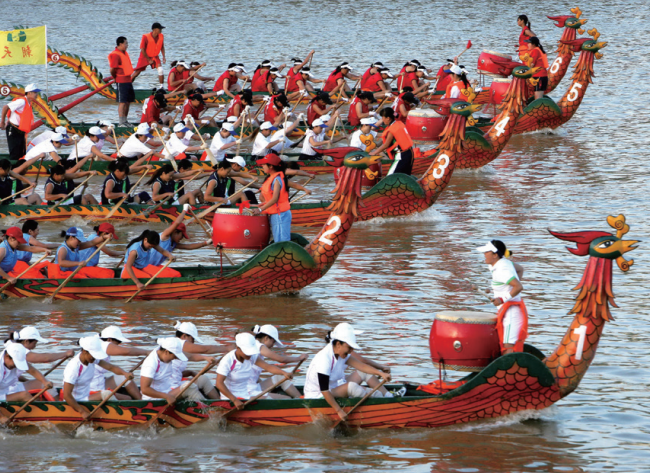
Phoenix boat race at the Daughter's Day [Photo provided to chinadaily.com.cn]
Being the birthplace of the empress, Guangyuan is endowed with a number of valuable historic relics. In addition, "Daughter's Day" also originated in Guangyuan.
Daughter's Day was first celebrated by the local community in celebration of Empress Wu Zetian. According to folklore, the twenty-third of the first lunar month is the birthday of Empress Wu Zetian, so local people host cultural and commercial activities on this day to celebrate her birth. In 1988, Guangyuan Municipal Government resumed the folk holiday Daughter's Day on September 1 (calendar month).
Red Culture
Guangyuan has been a city of heroes since ancient times.
The Fourth Red Army Front fought in Guangyuan for two years and four months, between first entering Wangcang county at the start of 1933 and the last troops leaving Qingchuan in April 1935.
Guangyuan is a key part of the Sichuan-Shaanxi Revolutionary Base - a Party, Government and Army Command Center of the Fourth Red Army Front, and the start of the army's long march. In this land, the Red Army spirit of wisdom, bravery, solidarity, and persistence was first forged.
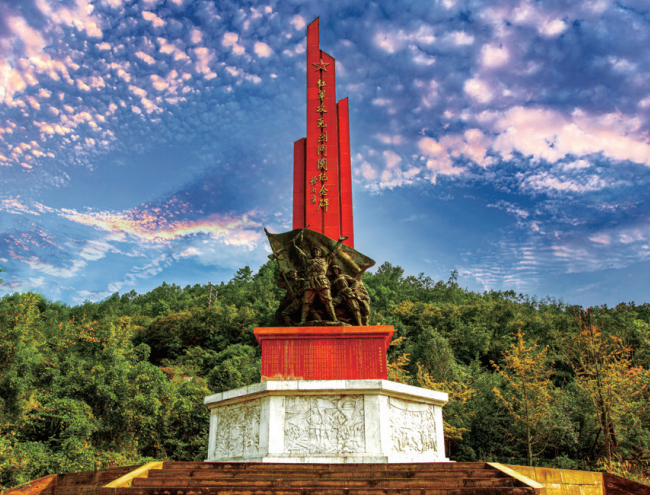
Monument for commemorating the Red Army's conquest of Jianmen Pass [Photo provided to chinadaily.com.cn]
As the Red Army left footprints all across Guangyuan, the city has kept a number of relics, sites and remains.
Featuring a total of 26 Red Army relics including the Red Army Ferry, Wangcang Red Army Town, Mumen Meeting Site, Red Army Battlefield Relics at Jianmen Pass, Zhaohua Taigong Red Army Mountain, and Tangjia River Motian Peak, as well as stone-carved inscriptions, Guangyuan offers substantive red tourism resources with rich cultural elements.
Northern Sichuan Folk Culture
Local folk customs include the Maliu folk embroidery of Chaotian, the paper-cutting of Cangxi, lion dancing of Yuanba, Duangong Drama of Wangcang, Bailong Paper Dolls of Jiange, Rucao Gong and Drum of Qingchuan, Baihua Stone Carving of Lizhou, Tiyang Drama of Zhaohua, the Gong and Drum of the Li family, and traditional lion dances.
Here are some brief descriptions of Baihua Stone Carving of Lizhou, Maliu Embroidery of Chaotian, Rucao Gong and Drum of Qingchuan and Tiyang Drama of Zhaohua - all listed as national intangible heritages.
Baihua Stone Carving is a folk handicraft unique to Guangyuan. Craftsmen use a "white flower stone" in red and white, based on its natural texture and colors, to create delicate artworks such as penholders, inkstones and vases with different carving techniques. Typical patterns include landscapes, figures, flowers and birds, dragons and phoenixes.
"Using special raw materials, Baihua Stone Carving makes full use of the natural stone coloration and forms in its creation. These are the natural limits to take into consideration. So the creation starts from the moment you set your eyes on the stone when collecting it in the mountains. Each and every piece of stone carving is the unique one," according to carver Tang Jun.
Maliu folk embroidery is named after its main production area. It is widely popular in Maliu, Zengjia, Yudong, Linxi and Xiaoan in Chaotian district. Passed down from mountain residents who lived highly self-sufficient lifestyles, Maliu embroidery has become a folk art based on needlework on linen. These embroideries can have diverse themes, such as mountains, rivers, trees, animals, plants and human figures. Mostly they are used on daily items with practical value, such as pillow cases, curtains, and handkerchiefs. Using special techniques, various colors and delicate designs, these embroidery works are widely used in households across the area.
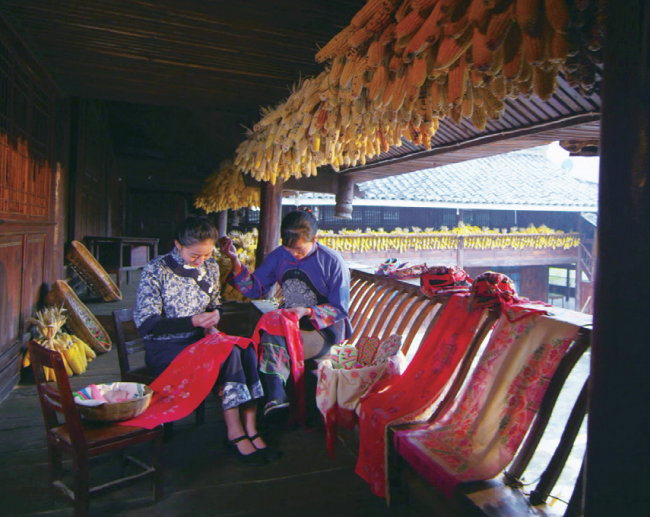
Maliu folk embroidery [Photo provided to chinadaily.com.cn]
Maliu embroidery is a systematic traditional folk embroidery of the Han people that has been well-preserved, free from external interference, over a long history. It's a primal item of intangible cultural heritage in China – one of the "living fossils" – with a very high cultural and artistic value. In 2008, Maliu embroidery was listed by the State Council on the second batch of intangible cultural heritages.
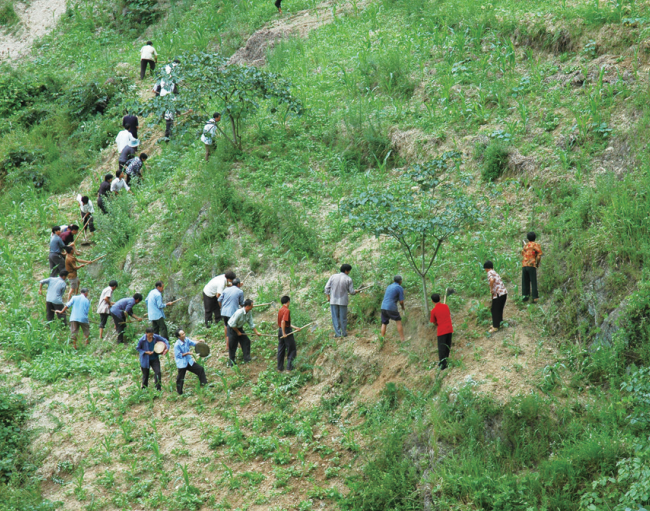
Northern Sichuan Gong and Drum [Photo provided to chinadaily.com.cn]
Northern Sichuan Gong and Drum is popular among Han people living in rural mountain areas in Sichuan province. The Rucao Gong and Drum of Qingchuan is a leading example. In 2006, it was listed by the State Council on the first batch of intangible cultural heritages.
Tiyang Drama of Zhaohua is widely practiced in Shejian Town and its neighboring area of Zhaohua district. Also known as Hua Hua Yuan drama, it was developed based on local Nuo drama (performed with distinguishing masks). As an expression of local people's wishes to receive good fortune and expel evil, this local drama has a special primal charm. In terms of its performance style, it combines puppet plays and real actors, and is employed on ceremonial occasions and for theatre performances. To the accompaniment of gongs and drums, Tiyang drama is sung in a minor key and contains other forms of aria.
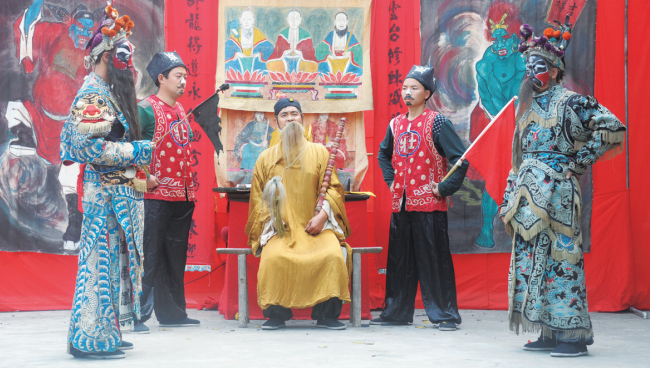
Tiyang Drama of Zhaohua in Shejian Town [Photo provided to chinadaily.com.cn]
